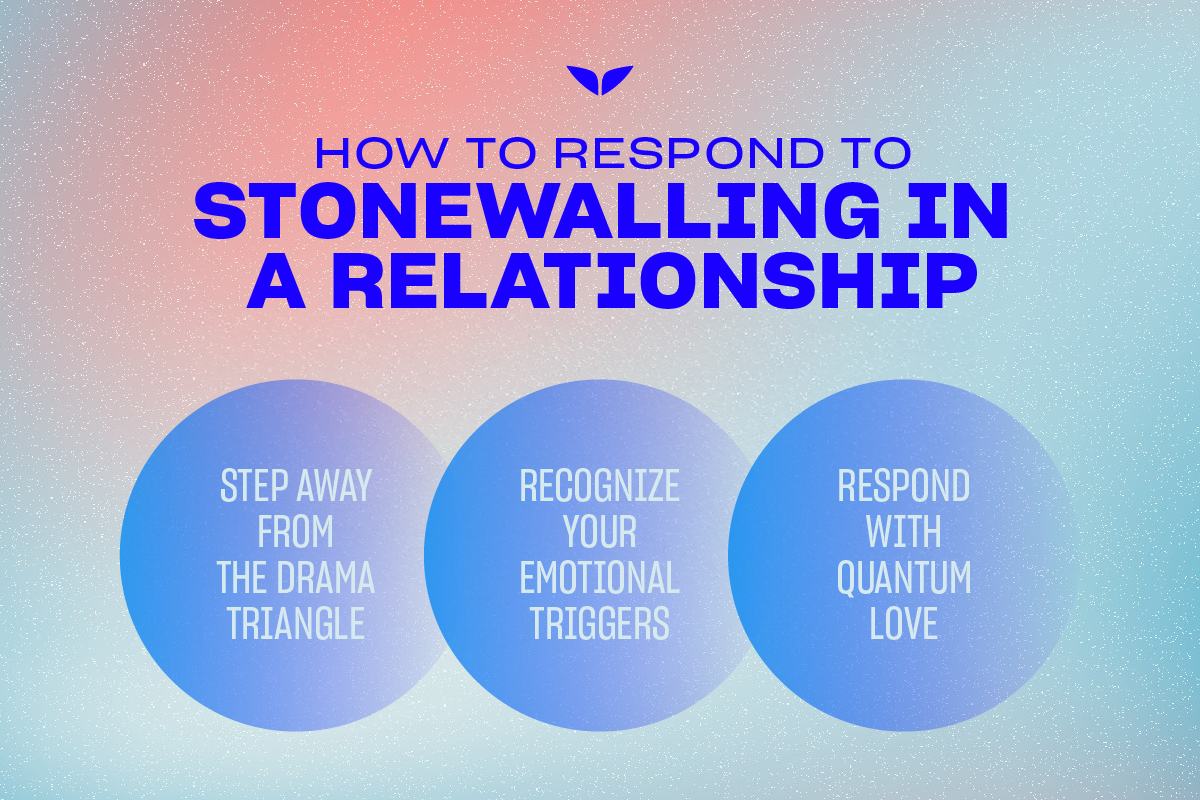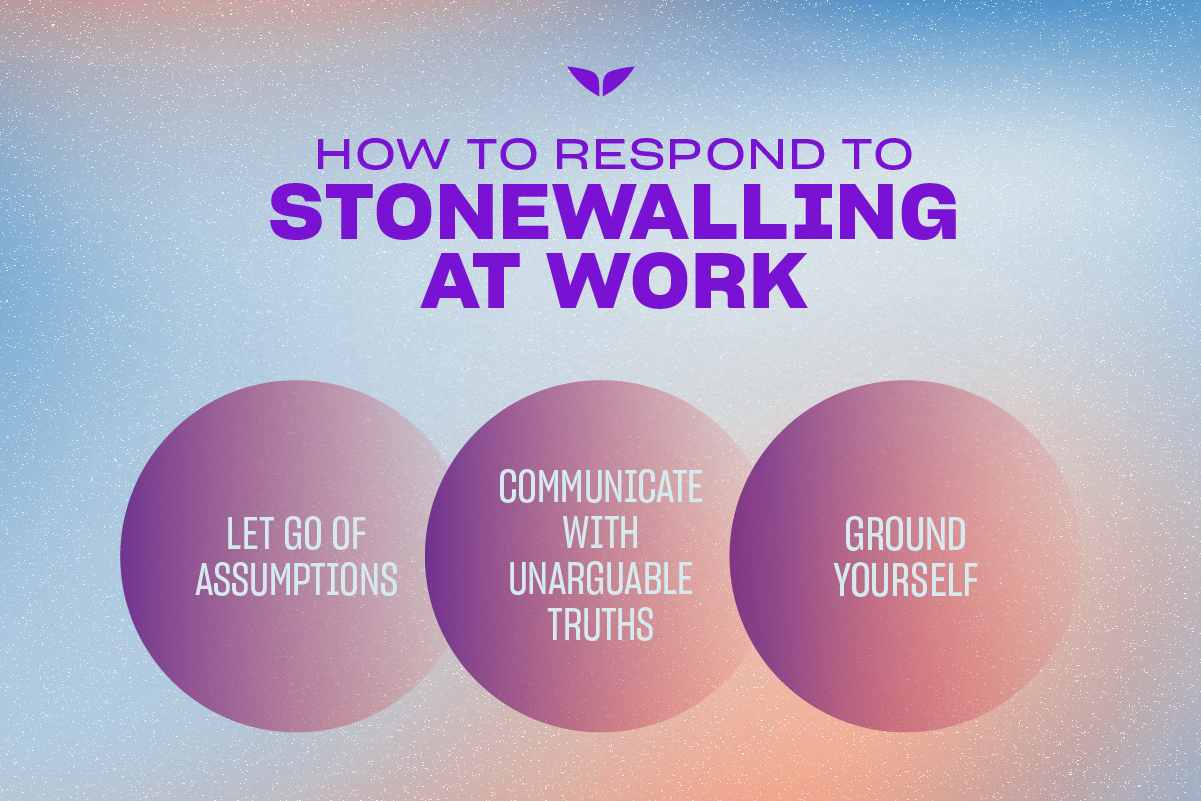Every relationship faces moments when both parties butt heads. It’s just an inevitable part of life.
But when one person shuts down and refuses to communicate, the other is likely being stonewalled. This can leave the latter feeling ignored and frustrated.
Knowing how to respond to stonewalling can make all the difference in keeping the lines of communication open. With the right approach, you can gently encourage your partner to reconnect and work through the issue together.
What is stonewalling?
The term “stonewalling” gets its name from the idea of a solid stone wall—impenetrable and unresponsive.
When a person stonewalls, they shut down meaningful conversation, either through short, sarcastic replies or by giving the silent treatment. Some even use gaslighting or walk away mid-conversation, leaving the other person unsure of how to move forward.
Why is someone stonewalling me?
People don’t stonewall for no reason. More often than not, there’s a cause behind it, like:
- Feeling overwhelmed and unsure of how to handle the situation.
- Withdrawing to avoid making the conflict worse.
- Too emotional to continue without getting upset.
- Avoiding vulnerability or confrontation.
- Protecting themselves from feeling hurt or exposed.
Let’s take a look at an example: those with a fearful avoidant attachment style, for instance, might emotionally shut down to protect themselves from confrontation or prevent things from intensifying. However, the reality is, it often makes things worse.
According to relationship expert Dr. John Gottman, stonewalling is one of the four major predictors of divorce. In heterosexual couples, he notes that 85% of stonewallers are men, who withdraw as a way to calm down, believing that staying silent will avoid further conflict. More often than not, stonewalling happens when someone feels emotionally flooded or unsure how to proceed without making the situation worse.
But if you’ve ever been stonewalled, you know how it feels…
…the sting of hearing, “I don’t want to talk about this.”
…the frustration of feeling isolated, exasperated, and helpless.
…the urge to scream just to get their attention, reaction, or even a simple acknowledgment.
“When you’re faced with somebody who’s silent like that, you escalate,” Dr. Gottman adds. “So it’s a very destructive pattern.”
But the thing is, can you do something about it? The short answer is yes.
How to respond to stonewalling in a relationship
“So many people feel trapped or out of their power in their relationships,” says Dr. Laura Berman, a relationship therapist, television host, and the trainer of Mindvalley’s Quantum Love: The Blueprint for Extraordinary Relationships.
And when there’s a communication breakdown between you and your partner, it can feel like you’re hitting a wall. The good news is, resources like free relationship classes offer practical tools for improving communication and handling issues such as stonewalling.
In order to really move to the quantum love zone and stay there, we must identify our worthiness-killing stories and loosen their grip on our thinking patterns.
— Dr. Laura Berman, trainer of Mindvalley’s Quantum Love: The Blueprint for Extraordinary Relationships

Dr. Berman, for example, suggests these strategies in her Quest to help you shift things when problems like stonewalling arise:
1. Step away from the drama triangle
In relationships, we often fall into roles—victim, villain, or hero—without realizing it. They’re part of what Dr. Berman calls the Drama Triangle.
Here’s taking a look at them more closely:
- The victim often feels powerless or helpless in the situation. Having this mindset can lead to passive-aggressive behavior, where you might not directly express your needs but instead expect your partner to notice and fix things.
- The villain might be defensive, critical, or unwilling to accept any responsibility. But one thing’s for sure: they’re the ones blamed for all the problems.
- The hero steps in to “fix” everything and make it better. However, this often comes at a cost: taking on the responsibility for everyone’s emotions can end up draining your own energy.
Now, if you’re being stonewalled, you might feel like a victim, blaming your partner (villain) for shutting you out or even trying to “fix” the situation (hero).
But the first step to responding to it is to “recognize when you’re on the drama triangle and get off it,” according to Dr. Berman. How can you tell? “The tried and true guarantee that you’re on the triangle is if you’re convinced you’re right. It’s as simple as that.”
So, instead of focusing on being “right,” shift your mindset. Ask yourself, “What is my role here, and how can I take responsibility for my own emotions?”
By stepping out of the Drama Triangle, you create space for healthier communication where both partners feel heard and respected.
2. Recognize your emotional triggers
Conflicts in relationships can bring out deep emotional reactions, especially those from your past.
Dr. Berman suggests these triggers are like “thorns” buried inside you—hidden pain from past experiences that gets touched in your present relationship. When you’re unable to recognize or manage them, though, misunderstandings and negative feelings often surface.
“In order to really move to the quantum love zone and stay there, we must identify our worthiness-killing stories and loosen their grip on our thinking patterns,” Dr. Berman advises.
Here’s how you can do so using her “thorny story timeline”:
- Start by centering yourself. Take a moment to breathe deeply and open your heart, creating space to explore your emotions without judgment.
- Think back to your earliest memory of feeling let down, abandoned, or hurt. Write this memory down, along with your approximate age.
- Map out similar memories, moving from left to right, like a timeline. Include moments where you felt emotionally or physically abandoned.
- Once your timeline is complete, revisit each memory. How did you feel during these moments? Reflect on the emotions and experiences through the lens you had as a child. These emotions may be fueling your reactions today.
“When you can lovingly forgive, detach from, and observe those events that have happened to you from a coherent home frequency,” says Dr. Berman. “Then you can release it; you can love it; you can bless it, and you can let that energy go.”
3. Respond with quantum love
With any kind of challenging behavior, you best believe the energy around that person is not great. But if you learn how to respond to stonewalling by tapping into what Dr. Berman calls quantum love? Chances are, you’ll go about your day feeling calm, peaceful, and full of love, no matter what’s happening around you.
That’s what quantum love is all about—aligning yourself with a higher frequency, or “home frequency,” as Dr. Berman calls it. How?
- Ground yourself with deep breaths to stay centered and avoid reacting emotionally.
- Pay attention to any tension or stress in your body, acknowledge it, and then shift your focus to how you want to feel—calm, connected, and at peace.
- Identify the feeling you desire in your relationship. Whether it’s feeling loved or appreciated, use this as a guidepost for how you respond.
- Choose to stay in your home frequency. It not only affects you but can also change the energy around you.
- Imagine sending love and calmness to your partner, even if they’re stonewalling. This simple act can shift the dynamic between you.
When (or if) your partner is open to the idea, invite them to revisit the conversation with love. You’ll find it’s easier to break down walls and open up a meaningful dialogue when you’re both aligned with positive energy.
How to respond to stonewalling at work
No doubt, dealing with people who give you the silent treatment, cut you off mid-sentence, talk over you, or leave you feeling ignored can truly test your patience. Having it happen in relationships is one thing. But dealing with stonewallers in your workplace? It’s just as challenging.
According to a global study by the International Labour Organization (ILO), nearly 18% of workers have dealt with some form of psychological harassment, like being ignored or shut out. What’s more, many people don’t speak up about it because they feel embarrassed or think it’s not worth the hassle.
So, learning how to respond to stonewalling, especially at work, can help you stay grounded and avoid saying, “Peace out.”

Here are a few ways you can respond:
1. Let go of assumptions
Say you greet a coworker, but they walk right past you, or your boss snaps at you during a meeting. Your first instinct might be to think, “Did I do something wrong?” or “Do they hate me?”
It’s really easy to jump to conclusions or let frustration take over when you don’t have the full picture. As Dr. Berman says, “When we’re in a negative emotional state, it’s like you’re wearing those gray-colored glasses, and your whole worldview is clouded.”
But instead of overreacting, you can ask yourself questions like, “Am I reacting to what’s really happening or to my assumptions about the situation?” This is the power of focused attention—it can help you shift the energy.
You may then realize that your coworker didn’t hear you. Or your boss is stressed for reasons unrelated to you.
Remember, where your attention goes, energy flows.
2. Communicate with unarguable truths
When you’re going head-to-head with someone who refuses to engage in a real conversation, frustration can quickly build up. But instead of accusing your coworker or getting defensive, there’s a more effective way to communicate how you feel—by speaking unarguably.
Here are four steps to guide you through this process:
- Start with describing how your body feels in the moment. For example, say something like, “I feel a knot in my stomach” or “My shoulders are tense.” These are things no one can argue with because it’s your physical experience.
- Share the emotion behind it. For instance, “I feel stressed and uneasy because of the knot in my stomach.” This helps your coworker understand what’s going on with you emotionally.
- Tell the story you’re creating in your mind. Acknowledge that your feelings might be based on assumptions. You could say, “I’m feeling stressed and uneasy because I have this story in my head that you’re upset with me for missing the last deadline.”
- End with what you need or want from the situation. For example, “I would like it if we could clear the air and work through any concerns so we can move forward.”
“When you’re speaking unarguably, you’re speaking truths that apply only to you,” explains Dr. Berman. “So you’re not projecting anything… nor are you making assumptions or accusations about how they’re thinking or feeling.”
3. Ground yourself
When someone’s energy is off at work—whether they’re snapping at you, giving you the cold shoulder, or just in a bad mood—it’s easy to think, “Oh, there they go again.”
David Feinstein, a clinical psychologist who co-trains Mindvalley’s The Energies of Love Quest with his wife, Donna Eden, explains that instead of letting their mood affect you, you can recognize that their energy is scrambled.
And with that awareness, you can choose to ground yourself and stay centered, no matter what’s going on around you, using the Four Thumps technique.
Here’s how to do it:
- Tap your cheekbones. This connects to your stomach meridian and grounds your energy down to your feet.
- Move to the K-27 points. Located just below your collarbone, these points clear your energy and keep it flowing smoothly.
- Tap your thymus. Tapping on the center of your chest supports your immune system and boosts vitality.
- Tap your spleen points. Located below your bra line, these points help you process information and release toxins.

Frequently asked questions
What are some common signs of stonewalling?
When it comes to stonewalling, the line of communication is practically nonexistent. But how do you know you’re being shut out? Here are some signs to look out for:
- Giving one-word answers or no response at all.
- Avoiding eye contact.
- Turning their body away.
- Walking out of the room mid-conversation.
- Talking over the current conversation.
- Saying things like, “Just drop it.”
- Using sarcasm or passive-aggressive comments.
Forget meaningful conversations. Chances are high that you’ll be left without so much as a “but…”
What is the antidote to stonewalling?
When stonewalling occurs, it’s essential to manage your emotions and create a space for open communication. Here are steps you can take:
- Self-soothe before continuing. If you’re feeling emotionally overwhelmed, take a break to calm yourself. According to Dr. Gottman, taking a 20-minute time out can help you clear your mind before jumping back into the conversation.
- Really listen. When you resume the discussion, make sure the other person knows you’re paying attention. You could say something like, “I get that this is tough” or “How can I help make this easier for you?”
- Create a safe space for emotions. Show empathy rather than reacting defensively. Focus on understanding the reason behind the silence—this can encourage the other person to open up.
These approaches can help defuse the situation and get a healthier, more productive exchange going.
How do you respond to stonewalling over text?
We all know how text messages can be misinterpreted, usually because we can’t hear the tone of the person’s voice or observe their body language.
But if you see the signs that you’re getting stonewalled digitally, here’s how you can handle it:
- Stay calm and avoid escalating the situation.
- Gently point out how their silence or short replies are affecting you. For example, “I feel like we’re not really communicating right now. Can we try to talk this through?”
- Be patient and give them space to process their emotions.
- Offer to continue the conversation when they’re ready.
- Avoid pushing too hard, as this might make them retreat even more.
It’s all about finding the balance. Give them space and let them know that you’re open to meaningful, constructive communication.
Break the barriers, build the bonds
At the end of the day, relationships—whether at work or at home—are about connection. And staying connected takes a little more than just words.
So, if you’re curious about how energy can transform your relationships, why not explore more? Dr. Laura Berman’s Quantum Love: The Blueprint for Extraordinary Relationships and Donna Eden and David Feinstein’s The Energies of Love Quest on Mindvalley offer tools that can guide you when communication breaks down or emotions run high.
With a free Mindvalley account, you’ll not only get access to the first lessons of these quests (and many others), but you can also enjoy daily meditations and be part of a vibrant, ever-growing circle of changemakers and lifelong learners…
…like Ana, a public health administrator in Los Angeles, U.S., whose perception of love and relationships changed with the knowledge, techniques, meditations, and growth work she learned from Dr. Berman.
…and Dani and James from Fairmont, U.S., who use the energy techniques they learned from Donna and David to manage their stress and communicate clearly. “We have been able to strengthen our connection, enhance our communication, deepen our compassion for one another and ourselves, and we now have strong tools and techniques to help us manage through whatever comes our way.”
Their words reflect the true essence of what you can experience here. The door is open—step in whenever you’re ready.
Welcome in.










